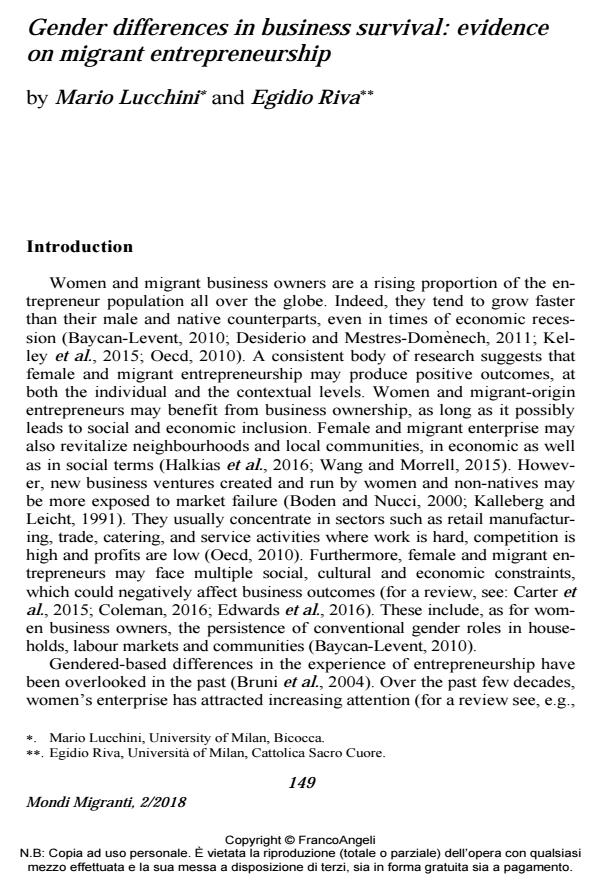Gender differences in business survival: evidence on migrant entrepreneurship
Titolo Rivista MONDI MIGRANTI
Autori/Curatori Mario Lucchini, Egidio Riva
Anno di pubblicazione 2018 Fascicolo 2018/2
Lingua Inglese Numero pagine 20 P. 149-168 Dimensione file 296 KB
DOI 10.3280/MM2018-002008
Il DOI è il codice a barre della proprietà intellettuale: per saperne di più
clicca qui
Qui sotto puoi vedere in anteprima la prima pagina di questo articolo.
Se questo articolo ti interessa, lo puoi acquistare (e scaricare in formato pdf) seguendo le facili indicazioni per acquistare il download credit. Acquista Download Credits per scaricare questo Articolo in formato PDF

FrancoAngeli è membro della Publishers International Linking Association, Inc (PILA)associazione indipendente e non profit per facilitare (attraverso i servizi tecnologici implementati da CrossRef.org) l’accesso degli studiosi ai contenuti digitali nelle pubblicazioni professionali e scientifiche
This paper draws on a longitudinal dataset of 165,515 firms that were economically active between 1997 and 2012 in Milan (Italy) to study gender dif-ferences in business survival within and between different eighteen groups, formed on the basis of the country of birth of the entrepreneurs. Kaplan-Meier estimates and piecewise-constant exponential hazard models show that, holding a set of individual and business covariates constant, the risk of business closure is always higher for female single proprietors. The highest gender differences in business survival are found among entrepreneurs born in Bangladesh, Morocco, and Sene-gal. Conversely, for female single proprietors born in Italy and China median sur-vival time and the risk of business closure are quite similar to those of their male counterparts.
Questo studio utilizza i dati relativi all’universo delle ditte individuali (N=165,515) che sono state attive a Milano e provincia tra il 1997 e il 2012 per studiare le disparità di genere che vi sono, quanto alla mortalità di impresa, entro e tra 18 gruppi etnici. Le analisi condotte, mediante lo stimatore di Kaplan-Meier e modelli di regressione esponenziale “piecewise-constant”, indicano che, controllando per una serie di caratteristiche del titolare di impresa e dell’impresa stessa, il rischio di mortalità è più elevato tra le ditte individuali a titolarità femminile. I differenziali di genere più elevati si riscontrano tra le ditte individuali il cui titolare è nato in Bangladesh, Morocco, and Senegal. Per contro, tra le ditte individuali i cui titolari sono nati in Italia e Cina non si riscontrano sostanziali disparità di genere in merito ai tempi mediani e i tassi di sopravvivenza.
Parole chiave:Imprese immigrate; disparità di genere; mortalità di impresa; tempi di sopravvivenza.
- Structural Equation Models to Determine the Relationship Between Startup Incubation Stages and the Graduation Rate of Incubators in Spain Ana Asensio-Ciria, Carmen De-Pablos-Heredero, Francisco José Blanco Jiménez, José Luis Montes Botella, Antón García Martínez, in Sustainability /2025 pp.733
DOI: 10.3390/su17020733 - Multidisciplinary Approach to Entrepreneurship Education for Migrants Jean-François Rougé, pp.112 (ISBN:9781799829256)
Mario Lucchini, Egidio Riva, Gender differences in business survival: evidence on migrant entrepreneurship in "MONDI MIGRANTI" 2/2018, pp 149-168, DOI: 10.3280/MM2018-002008